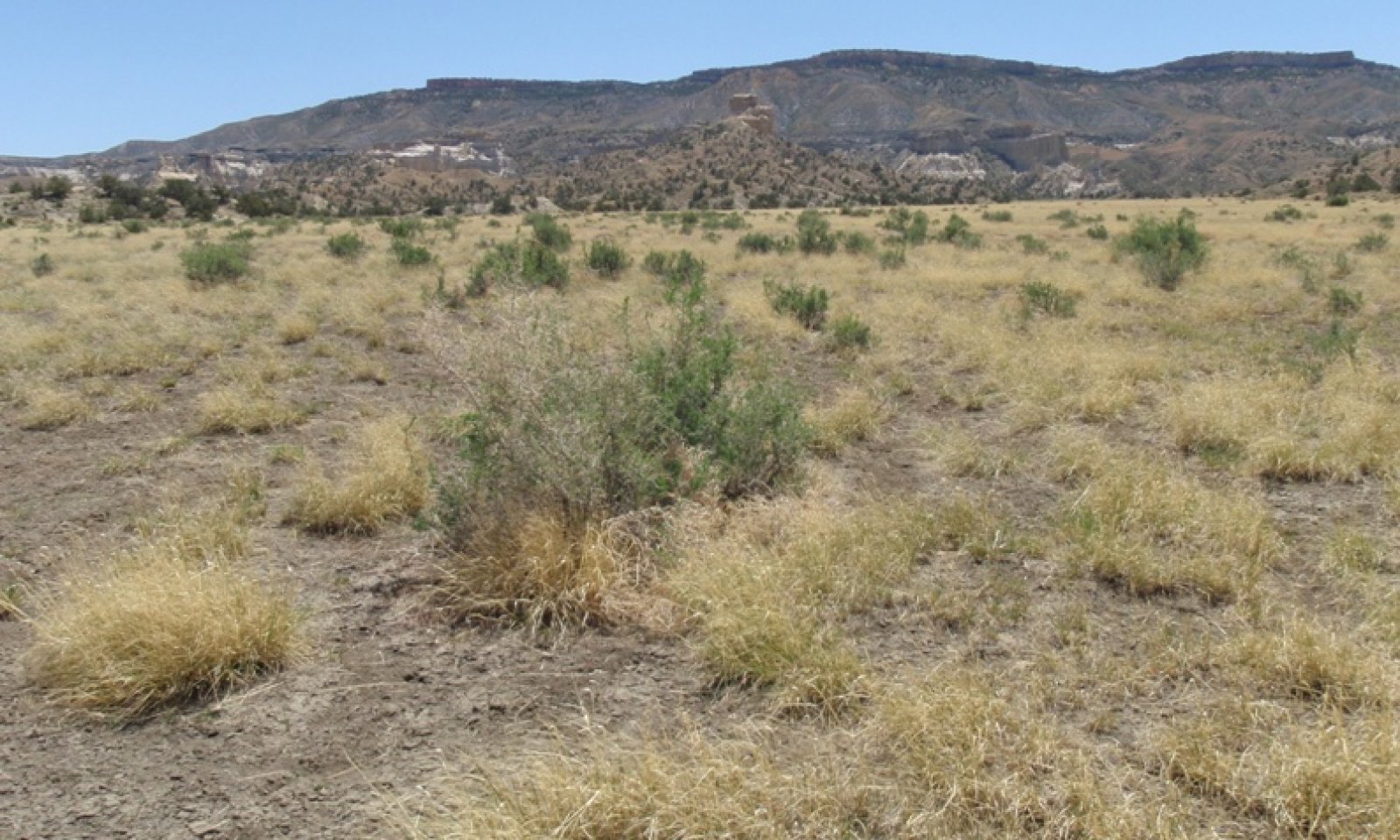

Natural Resources
Conservation Service
Ecological site R035XC309AZ
Clay Loam Terrace 10-14" p.z. Saline-Sodic
Last updated: 5/20/2025
Accessed: 12/21/2025
General information
Provisional. A provisional ecological site description has undergone quality control and quality assurance review. It contains a working state and transition model and enough information to identify the ecological site.
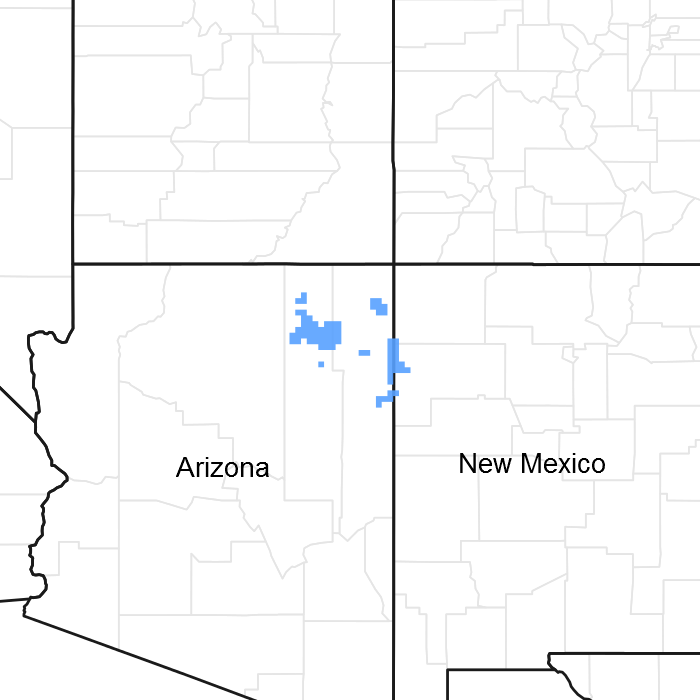
Figure 1. Mapped extent
Areas shown in blue indicate the maximum mapped extent of this ecological site. Other ecological sites likely occur within the highlighted areas. It is also possible for this ecological site to occur outside of highlighted areas if detailed soil survey has not been completed or recently updated.
MLRA notes
Major Land Resource Area (MLRA): 035X–Colorado Plateau
This ecological site is found in Common Resource Area 35.3 – the Colorado Plateau Sagebrush – Grasslands.
The Common Resource Area occurs within the Colorado Plateau Physiographic Province. It is characterized by a sequence of flat to gently dipping sedimentary rocks eroded into plateaus, valleys and deep canyons. Elevations range from 4800 to 6700 feet and precipitation averages 10 to 14 inches. The elevation range is lower (about 4500 to 6000 ) on the western side of the Colorado Plateau along the Grand Canyon, and moves up about 500 to 800 feet higher on the eastern side in the areas of the Navajo and Hopi Indian Reservations due to rain shadow effects from the Kaibab Plateau and Mogollon Rim. Common vegetation in this region includes Wyoming big sagebrush, Utah juniper, Colorado pinyon - cliffrose, Mormon tea, fourwing saltbush, blackbrush Indian ricegrass, needle and thread, western wheatgrass Galleta, black grama, blue grama, and sand dropseed. Sedimentary rock classes dominate the plateau with volcanic fields occurring for the most part near its margin. The soil temperature regime is mesic and the soil moisture regime is ustic aridic.
Ecological site concept
The ecological site concept for the LRU 35XC includes big sagebrush. R035XC309AZ is a salty bottomland site that would not exist with big sagebrush and more likely resembles the vast expanses of greasewood drainages in LRU 35.
Table 1. Dominant plant species
| Tree |
Not specified |
|---|---|
| Shrub |
(1) Atriplex canescens |
| Herbaceous |
(1) Pascopyrum smithii |
Physiographic features
This are deep to very deep, saline-sodic soils on terrraces, valley floors, alluvial flats and swales that benefit from run-in moisture from adjacent uplands. The soil surface texture generally range from clay loam to clayey textures, but it does not include soils with shrink/swell clays at the surface. The soils are saline-sodic.
Table 2. Representative physiographic features
| Landforms |
(1)
Terrace
(2) Alluvial flat (3) Valley floor |
|---|---|
| Flooding duration | Extremely brief (0.1 to 4 hours) to very brief (4 to 48 hours) |
| Flooding frequency | None to rare |
| Ponding duration | Very brief (4 to 48 hours) |
| Ponding frequency | None to rare |
| Elevation | 4,800 – 6,700 ft |
| Slope | 8% |
| Aspect | Aspect is not a significant factor |
Climatic features
Winter summer moisture ratios range from 70:30 to 60:40. Late spring is usually the driest period, and early fall moisture can be sporadic. Summer rains fall from June through September; moisture originates in the Gulf of Mexico and creates convective, usually brief, intense thunderstoms. Cool season moisture from October though May tends to be frontal; it originates in the Pacific and the Gulf of California and falls in widespread storms with longer duration and lower intensity. Precipitation generally comes as snow from December through February. Accumulations above 12 inches are not common but can occur. Snow usually lasts for 3-4 days, but can persist much longer. Summer daytime temperatures are commonly 95-100 F and, on occasion, exceed 105 F. Winter air temperatures can regularly go below 10 F and have been recorded below -20 F.
Table 3. Representative climatic features
| Frost-free period (average) | 168 days |
|---|---|
| Freeze-free period (average) | 193 days |
| Precipitation total (average) | 14 in |
Figure 2. Monthly precipitation range
Figure 3. Monthly average minimum and maximum temperature
Influencing water features
The soil moisture on this ecological site comes from precipitation and run-on moisture following storm events. The site may also benefit from lateral underground water movement from the streambed for periods of time after the surface water has drained off. This additional moisture allows this site to produce significantly more vegetation than upland sites that depend entirely on rainfall.
Soil features
Soils are deep to very deep and well-drained. They are formed from alluvium derived from sandstone, shale, and siltstone. The soil surface texture generally range from loam to silty clay loams, but some sites may have clayey textures. Subsurface horizon textures are generally clay loam, silty clay loam, sandy clay, and may have stratified loamy soils. The soil is slightly to strongly effervescent in the surface and subsurface profile. Available water capacity is high. Soils are moderately to strongly alkaline (pH 7.9-8.6) and are affected by soluble salts.
Soil survey map unit components correlated to this ecological site include:
SSA 711 Navajo Mountain Area MU 17 Lybrook and Tsosie;
SSA-713 Chinle Area MU's 9 Begay, 48 Sodic Ustic Haplocambids, 54 Campanile, 55 Tsosie & Councelor;
SSA 715 Fort Defiance Area MU 90 Gish and Querencia.
Table 4. Representative soil features
| Parent material |
(1)
Alluvium
–
sandstone and shale
|
|---|---|
| Surface texture |
(1) Silt loam (2) Silty clay loam (3) Clay loam |
| Family particle size |
(1) Loamy |
| Drainage class | Moderately well drained to well drained |
| Permeability class | Slow to very slow |
| Soil depth | 40 – 80 in |
| Surface fragment cover <=3" | 2% |
| Surface fragment cover >3" | Not specified |
| Available water capacity (0-40in) |
7.8 – 12 in |
| Calcium carbonate equivalent (0-40in) |
15% |
| Electrical conductivity (0-40in) |
8 mmhos/cm |
| Sodium adsorption ratio (0-40in) |
13 |
| Soil reaction (1:1 water) (0-40in) |
7.9 – 8.6 |
| Subsurface fragment volume <=3" (Depth not specified) |
Not specified |
| Subsurface fragment volume >3" (Depth not specified) |
Not specified |
Ecological dynamics
An ecological site is not a precise assemblage of species for which the proportions are the same from place to place or from year to year. In all plant communities, variability is apparent in productivity and occurrence of individual species. Spatial boundaries of the communities; however, can be recognized by characteristic patterns of species composition, association, and community structure. The historic climax plant community for this ecological site has been described by sampling relict or relatively undisturbed sites and/or reviewing historic records. The historic climax plant community is the plant community that evolved over time with the soil forming process and long term changes in climatic conditions of the area. It is the plant community that was best adapted to the unique combination of environmental factors associated with the site.
Natural disturbances, such as drought, fire, grazing of native fauna, and insects, are inherent in the development and maintenance of these plant communities. The effects of these disturbances are part of the range of characteristics of the ecological site. Fluctuations in plant community structure and function caused by the effects of natural disturbances help establish the boundaries and characteristics of an ecological site. They are accounted for as part of the range of characteristics of the ecological site. Recognizable plant community phases are identified in the reference state of the ecological site. Some sites may have a small range of variation, while others have a large range. Some plant community phases may exist for long periods of time, while others may only occur for a couple of years after a disturbance.
Deterioration of the plant community, hydrology, or soil site stability on an ecological site can result in crossing a threshold or potentially irreversible boundary to another state, or equilibrium. This can occur as a result of the loss of soil surface through erosion, the loss of the stability of the site due to disturbances that cause active erosion on the site, increases in the amounts and/or patterns or runoff from rainstorms, changes in availability of surface and subsurface water, significant changes in plant structural and functional types, or the introduction of non-native species. When these thresholds are crossed, the potential of the ecological site to return to the historic climax plant community can be lost, or restoration will require significant inputs . There may be multiple states possible for an ecological site, determined by the type and or severity of disturbance.
The known states and transition pathways for this ecological site are described in the state and transition model. Within each state, there may be one or more known plant community phases. These community phases describe the different plant community that can be recognized and mapped across this ecological site. The state and transition model is intended to help land users recognize the current plant community on the ecological site, and the management options for improving the plant community to the desired plant community.
Plant production information in this site description is standardized to the annual production on an air-dry weight basis in near normal rainfall years.
The State and Transition model shows the most common occurring plant communities likely to be encountered on this ecological site. This model may not show every possible plant community, but only those that are most prevalent and observed through field inventory. As more data is collected these plant communities may be revised, removed, and some added to reflect the ecological dynamics of this site.
State and transition model

Figure 4. STM - R035XC309AZ
More interactive model formats are also available.
View Interactive Models
More interactive model formats are also available.
View Interactive Models
Click on state and transition labels to scroll to the respective text
State 1 submodel, plant communities
State 2 submodel, plant communities
State 3 submodel, plant communities
State 1
Reference State
The general aspect of the Clay Loam Terracc, Saline-Sodic site is a grass-shrub mix characterized by alkali sacaton, western wheatgrass, fourwing saltbush and greasewood.
Community 1.1
Reference Plant Community

Figure 5. Clay Loam Terrace 10-14" p.z.
The dominant aspect of this site is a grass-shrub mix dominated by western wheatgrass, alkali sacaton, fourwing saltbush with scattered black greasewood. Other important grass species include Indian ricegrass, James' galleta, and squirreltail. The plant species most likely to increase or invade on this site are cheatgrass, Russian thistle, annual weeds, broom snakeweed, Greene rabbitbrush, rubber rabbitbrush, and black greasewood. Continuous grazing and drought conditions will decrease preferred herbaceous cover (cool season grasses), which is replaced by lower forage value grasses, forbs, and shrubs. A decrease in cool season grasses and increase of bare ground favor the establishment of annual weeds and shrubby species.
Figure 6. Annual production by plant type (representative values) or group (midpoint values)
Table 5. Annual production by plant type
| Plant type | Low (lb/acre) |
Representative value (lb/acre) |
High (lb/acre) |
|---|---|---|---|
| Grass/Grasslike | 450 | 650 | 850 |
| Shrub/Vine | 175 | 250 | 325 |
| Forb | 40 | 75 | 110 |
| Total | 665 | 975 | 1285 |
Table 6. Ground cover
| Tree foliar cover | 0% |
|---|---|
| Shrub/vine/liana foliar cover | 0% |
| Grass/grasslike foliar cover | 0% |
| Forb foliar cover | 0% |
| Non-vascular plants | 0% |
| Biological crusts | 0% |
| Litter | 15-30% |
| Surface fragments >0.25" and <=3" | 0-2% |
| Surface fragments >3" | 0% |
| Bedrock | 0% |
| Water | 0% |
| Bare ground | 30-50% |
Figure 7. Plant community growth curve (percent production by month). AZ3507, 35.3 10-14" p.z. alkali sacaton. Growth begins in late spring, most growth occurs in summer and early fall..
| Jan | Feb | Mar | Apr | May | Jun | Jul | Aug | Sep | Oct | Nov | Dec |
|---|---|---|---|---|---|---|---|---|---|---|---|
| J | F | M | A | M | J | J | A | S | O | N | D |
| 0 | 0 | 0 | 5 | 20 | 15 | 20 | 30 | 10 | 0 | 0 | 0 |
Figure 8. Plant community growth curve (percent production by month). AZ3531, 35.3 10-14" p.z. all sites. Growth begins in the spring and continues through the summer..
| Jan | Feb | Mar | Apr | May | Jun | Jul | Aug | Sep | Oct | Nov | Dec |
|---|---|---|---|---|---|---|---|---|---|---|---|
| J | F | M | A | M | J | J | A | S | O | N | D |
| 0 | 1 | 3 | 17 | 18 | 10 | 19 | 20 | 10 | 1 | 1 | 0 |
Figure 9. Plant community growth curve (percent production by month). AZ3563, 35.3 10-14" p.z. fourwing saltbush. Growth occurs in late spring through summer..
| Jan | Feb | Mar | Apr | May | Jun | Jul | Aug | Sep | Oct | Nov | Dec |
|---|---|---|---|---|---|---|---|---|---|---|---|
| J | F | M | A | M | J | J | A | S | O | N | D |
| 0 | 0 | 0 | 0 | 10 | 25 | 35 | 25 | 5 | 0 | 0 | 0 |
Community 1.2
Black Greasewood Shrubland
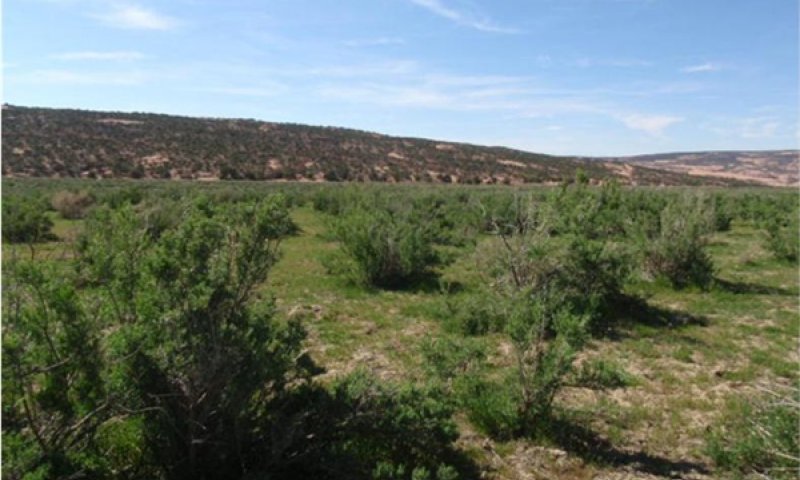
Figure 10. Greasewood Site
The dominant aspect of this plant community is a greasewood shrubland with lesser amounts of fourwing saltbush and rabbitbrush. The understory is dominated by alkali sacation, galleta along with increased annuals such as annual wheatgrass, mustards, buckwheats and globemallow.
Pathway 1.1a
Community 1.1 to 1.2


Unmanaged grazing, prolong drought
Pathway 1.2a
Community 1.2 to 1.1


Prescribed grazing/No grazing, favorable periods of precipitation.
State 2
Native/ Introduced Annuals State
The plant communities are shrub dominated with a decrease of perennials grasses and increase of annuals, especially introduced annuals such as cheatgrass, filaree and Russian thistle. This state is a result of a degraded biotic function where perennial grasses are reduced and compete with annuals for resources. There are seasonal shifts in annual production, which results in moderate to high amounts of bare ground during dry periods.
Community 2.1
Native Shrubs/Grasses with Introduced Annuals
This plant community still has a shrub canopy dominated by black greasewood and scattered fourwing, rabbitbrush and snakeweed. Perennial grasses are in decline with lesser amounts of alkali sacaton, galleta, squirreltail and western wheatgrass. Most perennial grasses occur with shrub canopies. Native and non-native annuals are present and well established across the site. Introduced annuals range from 2-15% by composition.
Community 2.2
Black Greasewood with Introduced Annuals
This plant community is dominated by black greasewood with annuals, both native and non-natives. There is few perennial grasses with most occuring in patches or within shrub canopies. Introduced annuals range from 2-15% by composition.
Pathway 2.1a
Community 2.1 to 2.2
Unmanaged continous grazing and/or surface disturbances, severe drought
Pathway 2.2a
Community 2.2 to 2.1
Prescribed grazing with rest, favorable precipitation
State 3
Eroded State
This state is characterized by a loss of hydrologic function along with a degraded biotic function. The site not longer benefits from overland run-in moisture from uplands. Deep incised channels and/or active gullies have changed the site's ability to hold and capture run-in mosisture. This site gets mosts of its moisture thru precipitation.
Community 3.1
Eroded, Black Greasewood
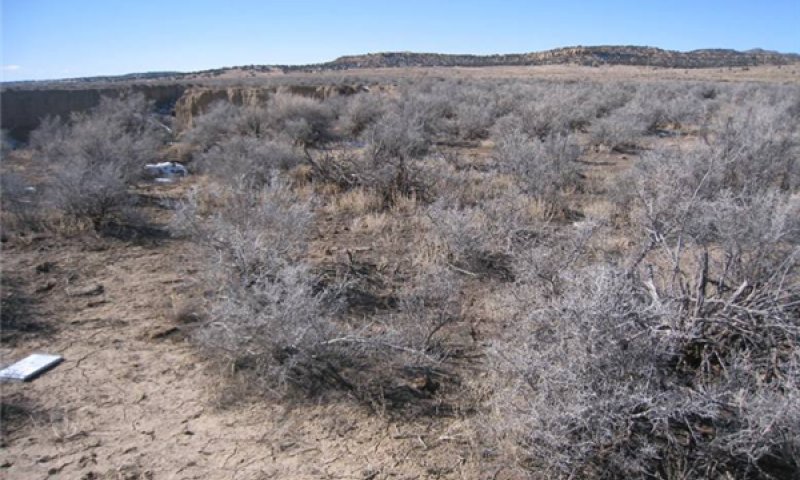
Figure 11. Gullied Site
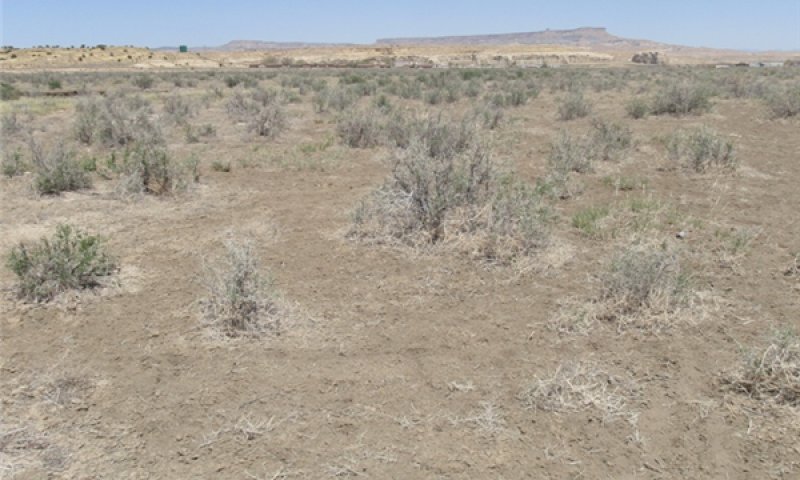
Figure 12. Gullied Site
This site is characterized by active gullies and deep incised channels with a black greasewood plant community. The dominant shrub is greasewood with a understory of annuals and very few scattered alkali sacaton and galleta. Common annuals include annual wheatgrass, globemallow, springparsley, stickseed, tansymustard, butterwort, goosefoots,sixweeks fescue, cheatgrass, filaree and Russian thistle.
Transition T1A
State 1 to 2
Introduction of non-native annuals, prolonged severe droughts, unmanaged continuous grazing.
Transition T1B
State 1 to 3
Prolonged severe droughts, unmanaged continuous grazing or frequent soil disturbance, loss of perenial grass cover, invasion of non-native annuals.
Transition T2A
State 2 to 3
Prolonged severe droughts, unmanaged continuous grazing or frequent soil disturbance, loss of perenial grass cover.
Additional community tables
Table 7. Community 1.1 plant community composition
| Group | Common name | Symbol | Scientific name | Annual production (lb/acre) | Foliar cover (%) | |
|---|---|---|---|---|---|---|
|
Grass/Grasslike
|
||||||
| 1 | Dominant Perennial Grasses | 400–700 | ||||
| alkali sacaton | SPAI | Sporobolus airoides | 200–500 | – | ||
| western wheatgrass | PASM | Pascopyrum smithii | 100–300 | – | ||
| James' galleta | PLJA | Pleuraphis jamesii | 50–150 | – | ||
| Indian ricegrass | ACHY | Achnatherum hymenoides | 25–100 | – | ||
| squirreltail | ELELE | Elymus elymoides ssp. elymoides | 25–100 | – | ||
| 2 | Other Grasses | 25–125 | ||||
| blue grama | BOGR2 | Bouteloua gracilis | 0–125 | – | ||
| spike dropseed | SPCO4 | Sporobolus contractus | 0–50 | – | ||
| sand dropseed | SPCR | Sporobolus cryptandrus | 0–50 | – | ||
| Fendler's threeawn | ARPUF | Aristida purpurea var. fendleriana | 0–25 | – | ||
| 3 | Annual Grasses | 0–25 | ||||
| Grass, annual | 2GA | Grass, annual | 0–25 | – | ||
|
Forb
|
||||||
| 4 | Common Forbs | 40–80 | ||||
| tansymustard | DESCU | Descurainia | 0–15 | – | ||
| tansyaster | MACHA | Machaeranthera | 0–15 | – | ||
| ragwort | SENEC | Senecio | 0–15 | – | ||
| globemallow | SPHAE | Sphaeralcea | 0–15 | – | ||
| longbeak streptanthella | STLO4 | Streptanthella longirostris | 0–10 | – | ||
| buckwheat | ERIOG | Eriogonum | 0–10 | – | ||
| flatspine stickseed | LAOC3 | Lappula occidentalis | 0–10 | – | ||
| curveseed butterwort | CETE5 | Ceratocephala testiculata | 0–10 | – | ||
| goosefoot | CHENO | Chenopodium | 0–10 | – | ||
| 5 | Other Forbs | 0–30 | ||||
| Forb, annual | 2FA | Forb, annual | 0–30 | – | ||
| Forb, perennial | 2FP | Forb, perennial | 0–30 | – | ||
|
Shrub/Vine
|
||||||
| 6 | Large Shrubs | 150–250 | ||||
| fourwing saltbush | ATCA2 | Atriplex canescens | 100–200 | – | ||
| greasewood | SAVE4 | Sarcobatus vermiculatus | 25–75 | – | ||
| rubber rabbitbrush | ERNA10 | Ericameria nauseosa | 0–20 | – | ||
| big sagebrush | ARTR2 | Artemisia tridentata | 0–20 | – | ||
| 7 | Low Shrubs | 25–75 | ||||
| Subshrub (<.5m) | 2SUBS | Subshrub (<.5m) | 0–25 | – | ||
| shadscale saltbush | ATCO | Atriplex confertifolia | 0–25 | – | ||
| Greene's rabbitbrush | CHGR6 | Chrysothamnus greenei | 0–25 | – | ||
| broom snakeweed | GUSA2 | Gutierrezia sarothrae | 0–25 | – | ||
| winterfat | KRLA2 | Krascheninnikovia lanata | 0–25 | – | ||
Interpretations
Animal community
This site is suitable for grazing by all classes of livestock during most periods, except when snow cover restricts availability of forage. Planned grazing systems adapt well on this site. This site will respond to management rather slowly, particularly on spots that have been historically been concentration areas.
When this site is located adjacent to upland wooded sites, it becomes increasingly important for wildlife by forming an 'edge'. This site, in excellent condition, provides early green feed for wildlife.
Recreational uses
This site occurs as terraces, swales and alluvial flats. It is open grassland interspersed with shrubs. Winters are cold and springs tend to be dry and quite windy. Late spring, summer, and fall are the most pleasant seasons for outdoor activities such as sport hunting, cross-country riding and wildlife observation.
Supporting information
Other references
Updates and revisions for this ESD were conducted as part of a 2007-2012 Interagency Technical Assistance Agreement between the Bureau of Indian Affairs–Navajo Region and the NRCS-Arizona.
Contributors
Ken Gishi
Kenneth Gishi
Larry D. Ellicott
Approval
Kendra Moseley, 5/20/2025
Rangeland health reference sheet
Interpreting Indicators of Rangeland Health is a qualitative assessment protocol used to determine ecosystem condition based on benchmark characteristics described in the Reference Sheet. A suite of 17 (or more) indicators are typically considered in an assessment. The ecological site(s) representative of an assessment location must be known prior to applying the protocol and must be verified based on soils and climate. Current plant community cannot be used to identify the ecological site.
| Author(s)/participant(s) | Dan Carroll, Kenneth Gishi |
|---|---|
| Contact for lead author | State Rangeland Management Specialist, NRCS-Arizona State Office, Phoenix, AZ |
| Date | 04/11/2011 |
| Approved by | Kendra Moseley |
| Approval date | |
| Composition (Indicators 10 and 12) based on | Annual Production |
Indicators
-
Number and extent of rills:
None is expected on shallow slopes. Steeper slopes that have run-in moisture from adjacent shallow sites in conjunction with bare ground can generate a few rills. -
Presence of water flow patterns:
A few discontinuous water flow patterns may be present, but short. -
Number and height of erosional pedestals or terracettes:
There can be occasional terracettes due to woody litter debris dams. -
Bare ground from Ecological Site Description or other studies (rock, litter, lichen, moss, plant canopy are not bare ground):
40% or less. This has the potential to produce moderate amounts of herbaceous cover. -
Number of gullies and erosion associated with gullies:
None expected. -
Extent of wind scoured, blowouts and/or depositional areas:
None. Any depositional areas are influenced by adjacent sites. -
Amount of litter movement (describe size and distance expected to travel):
Fine herbaceous litter is considerable distance by wind and water. Woody debris tends to stay in place except during large storm runoff events. Fine and woody herbaceous litter stays under the canopy of long lived perennial plants. -
Soil surface (top few mm) resistance to erosion (stability values are averages - most sites will show a range of values):
Soil surface stability in plant interspaces ranges from 1 to 2 with an average of 1.6. Soil stability underplant canopies ranges from 1 to 5 with an average of 3.5. -
Soil surface structure and SOM content (include type of structure and A-horizon color and thickness):
The soil surface horizon is 1-4 inches thick with textures of loams to silty clay loam. It is grayish in color (10YR) with weak fine platy structure. -
Effect of community phase composition (relative proportion of different functional groups) and spatial distribution on infiltration and runoff:
The plant community is composed of 70% grasses, 23% shrubs and 7% forbs. The annual average production of 900-1000 pounds per acre and low bare ground is beneficial for aiding infiltration and reducing runoff. -
Presence and thickness of compaction layer (usually none; describe soil profile features which may be mistaken for compaction on this site):
None expected. -
Functional/Structural Groups (list in order of descending dominance by above-ground annual-production or live foliar cover using symbols: >>, >, = to indicate much greater than, greater than, and equal to):
Dominant:
Warm season grasses >= cool season grasses >Sub-dominant:
Large ShrubsOther:
Low shrubs > Forbs > Annual grassesAdditional:
-
Amount of plant mortality and decadence (include which functional groups are expected to show mortality or decadence):
A small amount of mortality (<10%) is expected in the plant community. Shrubs will show the greatest loss during long term drought followed by grasses. Most plants are adapted to short term drought. -
Average percent litter cover (%) and depth ( in):
-
Expected annual annual-production (this is TOTAL above-ground annual-production, not just forage annual-production):
The annual production for an average year is 900-1000 pounds per acre. -
Potential invasive (including noxious) species (native and non-native). List species which BOTH characterize degraded states and have the potential to become a dominant or co-dominant species on the ecological site if their future establishment and growth is not actively controlled by management interventions. Species that become dominant for only one to several years (e.g., short-term response to drought or wildfire) are not invasive plants. Note that unlike other indicators, we are describing what is NOT expected in the reference state for the ecological site:
Plants that do invade this site and can increase are goosefoot (CHENO), Russian thistle (SATR12), cheatgrass (BRTE) and annual wheatgrass (ERTR13). There is a point where black greasewood (SAVE4) in combination with the plants previously mentioned create and represent plant communities that are generated from a degraded state. -
Perennial plant reproductive capability:
All plants native to the site are adapted to the climate and are capable of producing seeds, stolons and rhizomes in all but the most severe droughts.
Print Options
Sections
Font
Other
The Ecosystem Dynamics Interpretive Tool is an information system framework developed by the USDA-ARS Jornada Experimental Range, USDA Natural Resources Conservation Service, and New Mexico State University.
Click on box and path labels to scroll to the respective text.